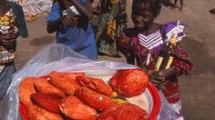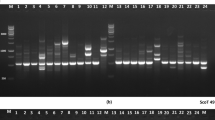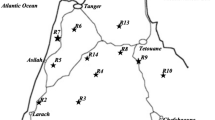Abstract
Globe artichoke (Cynara cardunculus L. var. scolymus L.) is a diploid (2n=2x=34), predominantly cross-pollinated plant native to the Mediterranean basin, and Italy contains the richest primary cultivated ‘gene pool’. Commercial production is mainly based on perennial cultivation of vegetatively propagated clones that are highly heterozygous and segregate widely when progeny-tested. Analysis of the artichoke genome by means of molecular markers has been limited to a few studies; here we report on the genetic relatedness among 118 artichoke accessions, including clones belonging to the same varietal type, two accessions of cultivated cardoon (C. cardunculus L. var. altilis DC.) and four accessions of wild cardoon [C. cardunculus L. var. sylvestris (Lamk) Fiori] as measured by amplified fragment length polymorphism (AFLP). Eight primer combinations yielded a total of 667 bands, of which 519 were polymorphic. Genetic similarities among accessions were calculated according to Jaccard’s Similarity Index and used to construct a dendrogram based on the unweighted pair group method using arithmetic averages. Our results demonstrate that AFLP markers can be useful in evaluating Cynara cardunculus genetic diversity and in classifying accessions to phylogenetic groups based on their genetic similarity values. Genetic variation among artichoke clones belonging to the same varietal type was in some cases higher than that found among accessions differently named and coming from different areas. The lowest Jaccard’s Similarity Index found within a varietal type can be considered as a threshold for the identification of accessions which share an analogous genetic background. This will enable the selection of representatives in order to develop and manage a germplasm ‘core collection’ as well as the identification of suitable material for future artichoke breeding efforts.



Similar content being viewed by others
References
Abbate V, Noto G (1981) Variabilità ambientale e genotipica in popolazioni siciliane di Cynara scolymus ed isolamento di nuovi cloni di Violetto di Sicilia. In: Atti 3rd Cong Int Studi sul Carciofo. Laterza, Bari, pp 797–807
Acquadro A, Portis E, Lanteri S (2003) Isolation of microsatellite loci in artichoke (Cynara cardunculus L. var. scolymus L.). Mol Ecol Notes 3:37–39
Adzet T, Puigmacia M (1985) High-performance liquid chromatography of caffeoylquinic acid derivatives of Cynara scolymus L. leaves. J Chromatogr 348:447–452
Anderson JA, Churchill GA, Autrique JE, Sorells ME, Tanksley SD (1993) Optimizing parental selection for genetic-linkage maps. Genome 36:181–186
Angiolillo A, Mencuccini M, Baldoni L (1999) Olive genetic diversity assessed using amplified fragment length polymorphisms Theor Appl Genet 98:411–421
Barbieri R (1959) Osservazioni sulla biologia del carciofo ‘Spinoso Sardo (Cynara cardunculus L. var. scolymus L.) Studi Sass Ann Fac Agric 19–36
Barcaccia G, Albertini E, Falcinelli M (1999) AFLP fingerprinting in Pelargonium peltatum: its development and potential in cultivar identification. J Hortic Sci Biotechnol 74:243–250
Basnizki J, Zohary D (1987) A seed planted cultivar of globe artichoke. HortScience 22:678–679
Basnizki J, Zohary D (1994) Breeding of seed planted artichoke. Plant Breed Rev 12:253–269
Bassam BJ, Caetano-Anolles G, Gresshoff PM (1991) Fast and sensitive silver staining of DNA in polyacrylamide gels. Analytic Biochemistry 19:680–683
Bruneton J (1995) Pharmacognosy phytochemistry medicinal plants. Lavoisier, Secaucus, N.Y., pp 218–219
Carr J, Xu M, Dudley JW, Korban SS (2003) AFLP analysis of genetic variability in New Guinea impatiens. Theor Appl Genet 106:1509–1516
Cervera MT, Cabezas JA, Sancha JC, de Toda FM, Martinez-Zapater JM (1998) Application of AFLPs to the characterization of grapevine Vitis vinifera L. genetic resources. A case study with accessions from Rioja (Spain). Theor Appl Genet 97:51–59
De Vos NE (1992) Artichoke production in California. HortTechnology 2:438–444
Debenedetti SL, Palacios PS, Wilson EG, Coussio JD (1993) HPLC analysis of caffeoylquinic acids contents in Argentine medicinal plants. Acta Hortic 333:191–199
Deidda M (1967) Contributo al miglioramento genetico del carciofo. In: Atti 1st Congr Int Studi sul Carciofo. Minerva Medica, Turin, pp 157–174
Dellacecca VV, Magnifico V, Marzi V, Porceddu E, Scarascia Mugnozza GT (1976) Contributo alla conoscenza delle varietà di carciofo coltivate nel mondo. In: Proc Int Congr Artichoke. Minerva Medica, Turin, pp 119–316
Elia A, Miccolis V (1996) Relationship among 104 artichoke (Cynara scolymus L.) accessions using cluster analysis. Adv Hortic Sci 10:158–162
FAO (2001) FAO report. Rome, Italy
Felsenstein J (1993) phylip, Phylogenetic inference package, version 3.5.7. A computer program distributed by the author: http://evolution.genetics.washington.edu/phylip.html. Department of genetics, University of Washington, Seattle, Wash.
Foury C (1969) Étude de la biologie florale de l’artichaut Cynara scolymus L.: Application à la sélection 2. Étude des descendances obtenues en fécondation contrôllèe. Ann Amelior Plant 19:23–52
Gebhardt R (1997) Antioxidative and protective properties of extracts from leaves of artichoke (Cynara scolymus L.) against hydroperoxide induced oxidative stress in cultured rat hepatocytes. Toxicol Appl Pharmacol 144:279–286
Gebhardt R (1998) Inhibition of cholesterol biosynthesis in primary cultured rat hepatocytes by artichoke (Cynara scolymus L.) extracts. J Pharmacol Exp Ther 286:1122–1128
Gebhardt R (2002) Prevention of taurolithocholate-induced hepatic bile canalicular distortions by HPLC-characterized extracts of artichoke (Cynara scolymus L.) leaves. Planta Med 68:776–779
Hill M, Witsenboer H, Zabeau M, Vos P, Kesseli R, Michelmore R (1996) PCR-based fingerprinting using AFLPs as a tool for studying genetic relationships in Lactuca spp. Theor Appl Genet 93:1202–1210
Hongtrakul V, Huestis GM, Knapp SJ (1997) Amplified fragment length polymorphisms as a tool for DNA fingerprinting sunflower germplasm: genetic diversity among oilseed inbred lines. Theor Appl Genet 95:400–407
Jaccard P (1908) Nouvelles recherches sur la distribution florale. Bull Soc Vaud Sci Nat 44:223–270
Kirkbride JH (1993) Biosystematic monograph of the genus Cucumis (cucurbitaceae). Parkway Publ, Parkway, N.C.
Lanteri S, Di Leo I, Ledda L, Mameli MG, Portis E (2001) RAPD, variation within and among populations of globe artichoke (Cynara scolymus L.), cv ‘Spinoso sardo’. Plant Breed 120:243–247
Lanteri S, Acquadro A, Quagliotti L, Portis E (2003) RAPD and AFLP assessment of genetic variation among and within populations of a landrace of pepper (Capsicum annuum L.) grown in north-west Italy. Genet Resour Crop Evol 50:723–735
Leus L, Demuynck E, De Riek J (2000) Genetic diversity of a collection of rose species and cultivars evaluated by fluorescent AFLP. Med Fac Landbouw Univ Gent 65:455–459
Lopez Anido FS, Firpo IT, García SM, Cointry EL (1998) Estimation of genetic parameters for yield traits in globe artichoke (Cynara scolymus L.). Euphytica 103:61–66
Maughan PJ, Maroof MAS, Buss GR, Huestis GM (1996) Amplified fragment length polymorphism (AFLP) in soybean: species diversity, inheritance, and near-isogenic line analysis. Theor Appl Genet 93:392–401
Mauromicale G, Copani V (1989) Caratteristiche biologiche e produzione di cloni diversi di carciofo isolati in popolazioni siciliane di Violetto di Sicilia. Tec Agric 41:3–17
Mauromicale G, Ierna A (2000) Panorama varietale e miglioramento genetico del carciofo. Inf Agrar 26:39–45
Mauromicale G, Morello N, Santoiemma G, Ierna A (2000) Nuove varietà per migliorare la cinaricoltura siciliana. Inf Agrar 26:47–51
Milbourne D, Meyer R, Bradshaw JE, Baird E, Bonar N, Provan J, Powell W, Waugh R (1997) Comparison of PCR-based marker systems for the analysis of genetic relationships in cultivated potato. Mol Breed 3:127–136
Miller T (1975) New artichoke clones. N Z J Agric 131:33–35
Paul S, Wachira FN, Powell W, Waugh R (1997) Diversity and genetic differentiation among populations of Indian and Kenyan tea [Camellia sinensis (L.) O Kuntze] revealed by AFLP markers. Theor Appl Genet 94:255–263
Pécaut P (1983) Amélioration des variétés d’artichaut: variétés à multiplication végétative, variétés à multiplication par semences, clones sans virus issus de multiplication in vitro. Procès-verbal de la Séance de 12 janvier, Acad Agric Fr, pp 69–78
Pécaut P (1993) Globe artichoke Cynara scolymus L. In: Kallo G, Bergh BD (eds) Genetic improvements of vegetable crops. Pergamon, Oxford, pp 737–746
Pejic I, Ajmone-Marsan P, Morgante M, Kozumplick V, Castiglioni P, Taramino G, Motto M (1998) Comparative analysis of genetic similarity among maize inbred lines detected by RFLPs, RAPDs, SSRs and AFLPs. Theor Appl Genet 97:1248–1255
Pochard E, Foury C, Chambonet D (1969) Il miglioramento genetico del carciofo. In: Atti 1st Congr Int Di Studi sul Carciofo. Minerva Medica, Turin, pp 117–143
Porceddu E, Dellacecca V, Bianco VV (1976) Classificazione numerica di cultivar di carciofo. In: Atti 2nd Congr Int Di Studi sul Carciofo. Minerva Medica, Turin, pp 1105–1119
Powell W, Morgante M, Andre C, Hanafey M, Vogel J, Tingey S, Rafalsky A (1996) The comparison of RFLP, RAPD, AFLP and SSR (microsatellite) markers for germplasm analysis. Mol Breed 2:225–238
Rohlf FJ (1993) ntsys-pc Numerical taxonomy and multivariate analysis system, version 1.80. Owner’s manual. Exter Software, New York
Rottenberg A, Zohary D (1995) The wild relatives and the wild ancestry of the cultivated artichoke. Genet Resour Crop Evol 43:53–58
Scarascia Mugnozza GT, Pacucci G (1976) Tipi di potenziale valore pratico isolati nell’ambito di un programma per il miglioramento genetico del carciofo. In: Atti 2nd Congr Int Studi sul Carciofo. Minerva Medica, Turin, pp 117–143
Sevcikova P, Glatz Z, Slanina J (2002) Analysis of artichoke (Cynara cardunculus L.) extract by means of micellar electrokinetic capillary chromatography. Electrophoresis 23:249–252
Shannon CE, Weaver W (1949) The mathematical theory of communication. University of Illinois Press, Urbana, Ill.
Sharma SK, Knox MR, Ellis THN (1996) AFLP analysis of the diversity and phylogeny of Lens and its comparison with RAPD analysis. Theor Appl Genet 93:751–758
Slanina J, Taborska E Musil P (1993) Determination of cynarine in the decoctions of the artichoke (Cynara cardunculus L.) by the HPLC method. Cesk Farm 42:265–268
Sonnante G, De Paolis A, Lattanzio V, Perrino P (2002). Genetic variation in wild and cultivated artichoke revealed by RAPD markers. Genet Resour Crop Evol 49:247–252
Tesi R (1976) Primi risultati del miglioramento genetico delle varietà toscane di Cynara cardunculus, var. scolymus. In: Atti 2nd Congr Int. Studi sul Carciofo. Minerva Medica, Turin, pp 747–763
Tivang J, Skroch PW, Nienhuis J, De Vos N (1996) Randomly Amplified Polymorphic DNA (RAPD) variation among and within artichoke (Cynara scolymus L.) cultivars and breeding populations. J Am Soc Hortic Sci 121:783–788
Tomkins JP, Wood TC, Barnes LS, Westman A, Wing RA (2001) Evaluation of genetic variation in the daylily (Hemerocallis spp.) using AFLP markers. Theor Appl Genet 102:489–496
Van Huylenbroeck J, Coart E, Janneteau F, De Riek J (2001) Identification of woody ornamentals by AFLP. In: Eucarpia Meet—Ornamental Symp Strategies New Ornamentals. Melle, Belgium
Vanella B, Porceddu E, De Pace C (1981) Applicazioni di metodi di analisi numerica per il miglioramento genetico del carciofo. In: Atti 3rd Congr Int Di Studi sul Carciofo. Laterza, Bari, pp 797–807
Vos P, Hogers R, Bleeker M, Reijand M, van de Lee T, Hornes M, Fritjers A, Pot J, Paleman J, Kuiper M, Zabeau M (1995) AFLP: A new technique for DNA fingerprinting. Nucleic Acids Res 23:4407–4414
Wagenbreth D (1996) Evaluation of artichoke cultivars for growing and pharmaceutical use. Beitr Zuchtungsforsch 2:400–403
Wang MF, Simon JE, Aviles IF, He K, Zheng QY, Tadmor Y (2003) Analysis of antioxidative phenolic compounds in artichoke (Cynara scolymus L.). J Agric Food Chem 51:601–608
Acknowledgements
We thank Dr. C. Comino for technical assistance, Dr. Duzyaman for providing the Turkish accessions, and Prof. G. Mauromicale for providing the wild cardon accessions and for critical reading of the manuscript.
Author information
Authors and Affiliations
Corresponding author
Additional information
Communicated by J.S. Heslop-Harrison
Rights and permissions
About this article
Cite this article
Lanteri, S., Saba, E., Cadinu, M. et al. Amplified fragment length polymorphism for genetic diversity assessment in globe artichoke. Theor Appl Genet 108, 1534–1544 (2004). https://doi.org/10.1007/s00122-003-1576-6
Received:
Accepted:
Published:
Issue Date:
DOI: https://doi.org/10.1007/s00122-003-1576-6




